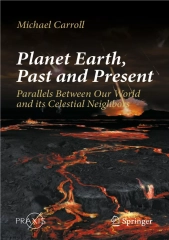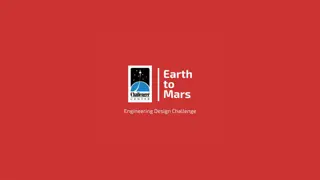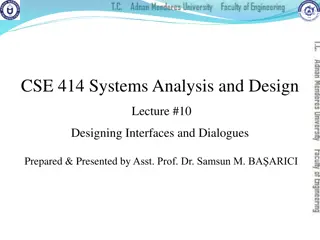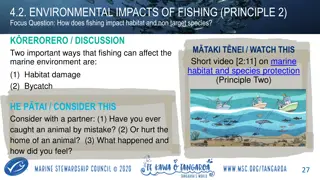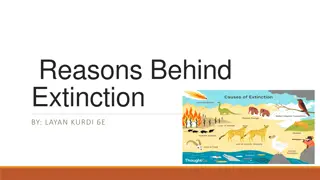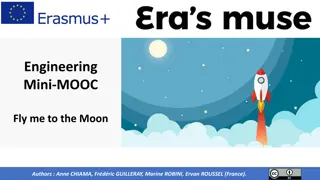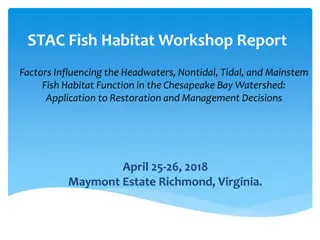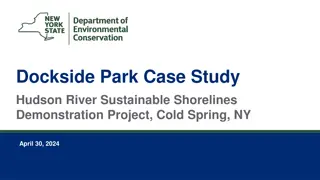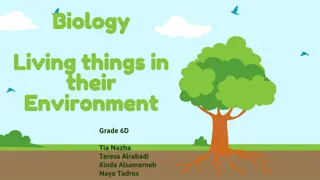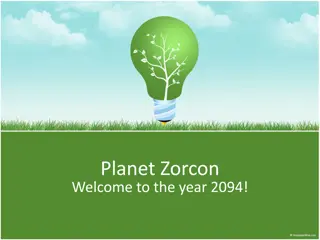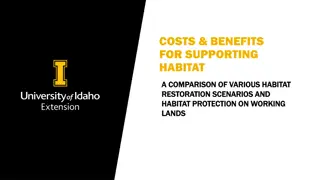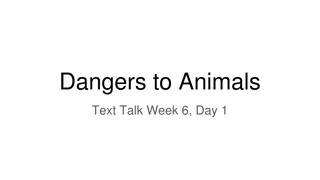Designing Your Own Planet: A Future Habitat Project
In the year 3000 AD, with Earth becoming overpopulated, you are tasked with designing a new planet to accommodate a portion of the population. Consider elements like atmosphere, climate, seasons, habitats, infrastructure, and more to create a unique and habitable world. Let your imagination soar as you craft a fictional planet with its own characteristics and features.
Download Presentation

Please find below an Image/Link to download the presentation.
The content on the website is provided AS IS for your information and personal use only. It may not be sold, licensed, or shared on other websites without obtaining consent from the author. Download presentation by click this link. If you encounter any issues during the download, it is possible that the publisher has removed the file from their server.
E N D
Presentation Transcript
LO To design your own planet
Your Task It is the year 3000 AD. Earth has become very populated. You have been assigned the task by the government to design a new planet to provide a home for some of the earths population to live on.
You will need to consider things like the following: what elements the planet will contain, the temperature, the size, whether it has moons, how to make it habitable, Are there animals and if so, what are they like? The vegetation Housing/shelter Infrastructure ( roads, buildings, power, schooling etc)
Start by considering if the planet is made up of gases like oxygen and nitrogen, or with other gases not found on Earth. Humans need oxygen to survive, but if your planet is not going to be populated with humans, your planet may not need oxygen at all. Your planet may be made up of one gas that requires special equipment to breath in, or several gases that mirror the atmospheric make up of Earth.[ You should also think about how the atmosphere appears on the planet. Is the atmosphere foggy and thick with white gases or does it have patches of poisonous gases that appear green or blue? Maybe sections of your planet contain different atmospheres, leading to a wide range of gases and elements on the planet. Describe the atmosphere of the planet 1]
Note the climate of the planet. You should also have a good idea of the climate or climates on the fictional planet. Consider if the planet has a variety of climates based on location or one overall climate.[2]Maybe the planet consists mostly of ice and it is always winter on the planet, with temperatures below zero. Or, perhaps there are areas of the planets that are tropical, with hot, humid temperatures and areas of the planet that are dry and arid.
Decide if there will be seasons on the planet. You should consider if there are going to be seasons on the planet and if so, how many seasons will there be. The seasons on the planet may mirror the seasons on planet Earth, consisting of spring, summer, fall, and winter. Maybe the seasons are limited to two, summer and winter, or there is only one constant season on the planet.[3]You may want the seasons to correspond with the climate and the atmosphere of the planet. Perhaps a planet that is made mostly of frozen water will have only one season: winter. Or, if the climate is tropical on the planet, it may be summer year round. Keep in mind the names of seasons on the planet can also be different than the ones we have on Earth. You are creating a fictional planet, after all, so you have the freedom to come up with new names for seasons and include them in your story.
Describe the landscapes on the planet. Think about how the planet looks in terms of landscape and terrain. Try to be specific about the landscapes on the planet and connect the landscape with the climate and atmosphere of the planet. This will make the planet seem more believable and cohesive to your reader.[4]Perhaps the planet consists of a variety of landscapes, such as ice capped mountains, grassy hills, desert plains, and tropical jungle. Or, maybe there is only one type of landscape on the planet, such as a planet made of ice that contains glaciers, ice walls, and frozen forests.[5] You should also consider if there are going to be bodies of water on the planet, such as oceans, lakes, and rivers. Perhaps there is only one long body of water that circles the entire planet or several lakes that are considered sacred to the people living on the planet.
Note if there are distinct landmarks on the planet Most planets that have been settled by a species will have distinct landmarks that have been built or created, such as a giant central tower or a monument to a particular historical figure. There may also be natural landmarks on the planet, like a sacred mountain peak or a dense, preserved forest.[6]You can make a specific landmark a key element .
Describe any natural resources on the planet. You should consider if there are going to be natural resources, like minerals or natural gas, on the planet. These natural resources could then serve an important purpose in your story set on the planet, as your characters may try to extract or use these natural resources for their own gain.You may include mineral resources like gold, iron, or coal. There may also be precious stones like diamonds or pearls on the planet. You may include natural resources like fossil fuels or natural gas. Or, the planet may contain lots of forests for timber and fertile land for growing crops.
Decide if there will be cities, towns or villages on the planet. You should decide if your planet will be divided into settled areas like cities, towns, or villages. Perhaps there are only a handful of major cities on your planet, and lots of small villages in remote areas. Or, maybe your planet is full of urban areas and large cities, with only a small amount of rural villages or areas.
Create a map of the planet. To get a better sense of the overall geography of the planet, you should sit down and sketch out a map. It does not necessarily have to be well rendered or well drawn. Instead, focus on getting down the general details of the planet, such as the names of the areas on the planet as well as key features of each area.[7]For example, maybe you are creating a planet that is divided into two sides: one of ice and one of sand. You may then label one side Frigid Land and list details about the atmosphere, climate, and landscape in this area. You may list: Blue atmosphere, below zero temperatures, populated by glaciers, ice walls, snow-capped mountains, and sparse forest.
Note the different life forms on the planet . You should consider who is inhabiting the fictional planet. Maybe you have human-like species who live on the planet or alien-like species who have colonized the planet. Perhaps there is a mix of both species who attempt to live in harmony on the planet.[8]Determine a rough estimate of the population of the different species on the planet. Maybe humans are outnumbered by aliens, or humans and aliens are outnumbered by a species of animal on the planet. You should consider the different races that live on the planet. Maybe there are different races of humans who live in specific areas or locations on the planet. There may be different races of aliens as well who only inhabit a specific area on the planet.
1. Consider the flora and fauna that exist on the planet, from mammals to insects to plant species. Try to be detailed about the biodiversity, as it can tell your reader a lot about the physical aspects of the world. It can also serve as useful plot points or character moments, where your character interacts with the biodiversity on the planet.[9]You may want to try using some of the unique biodiversity found on Earth as a jumping off point. Do some research on strange biodiversity on Earth and put it in as part of your planet s biodiversity.[10] 2. Another option is to take an existing plant or animal and make them more unique or strange. Your planet may be populated by grapevines that excrete blood, for example, or wildebeests who are only two inches tall. Get creative and turn familiar elements of our world into unique ones for your fictional planet. Create unique biodiversity for the planet.
Describe the history of the species on the planet . You should also consider how the planet was created. Write out a history of the planet, (did it used to have a species? Ar e they still there? . Is the planet a distant star that was inhabited by aliens who crash landed on it? Or did the species grow and evolve on the planet over a long period of time? Did they die out or was it inhabitable but by adding additional climate humans can now inhabit it.
Technological devices . You should also consider how technologically savvy your planet will be. Will it have access to advanced technology that uses signalling stations on the planet? Or does it use technology that is very similar to Earth's capabilities, with access to wi-fi and high speed internet? Keep in mind you are creating a fictional planet and you do not need to stick to realistic ideas of technology. You have the freedom to create your own versions of existing technology, such as cellphones that are called beam-hands or a version of the internet that is called simply "the Net". Get creative and do not be afraid to create your own technologies for the species on your planet.
Decide how magic works on the planet. You may decide to include magical elements on your planet .For example, perhaps there is a specific area of the planet that is known for its magical forest, which seems to swallow up anyone who enters. Or maybe the planet contains patches of green gas that can suffocate anyone who is not wearing the proper breathing gear. There may also be magical beings who exist as species on the planet. You may limit magic to only these magical beings, who bring magic with them, rather than have magic be a part of the planet s make up. treat your new world as a real world with its own physical rules. Whether you're creating a world on another planet or one on Earth, you need to know the rules. If there is magic, understand how it works in relation to the physical rules. If people can fly, there are still rules on how fast or high they can fly. Creating a realistic new world is about the way you define the rules and then being consistent.
Note how the planet functions within a larger system. You should also try to get a macro sense of the planet, where you consider if and how the planet exists within a larger system of planets. Maybe the planet is light years away from the nearest planet or perhaps it is under the domain of a larger planet in the solar system.[14]You should consider where the planet is located exactly within a larger system. The rules of the planet may also be based on its position in a solar system, where it is limited by a larger planet or in control of smaller planets. Think about the positioning of the planet in relation to other planets and celestial bodies, such as stars, meteorites, and black holes.
Think. Use your imagination. It is way in the future. What might have been invented? How could you make this planet good to live on. What about conservation? Preventing air pollution etc. You have the chance to make it better than earth. What would you change about earth?
Task 1 The planning stage Using the work sheet in resources entitled design a planet, make notes in detail about your new planet. Add lots of extra information on the back and include as many details as possible. Use all the headings on the slides and make notes about your planet. You will need this information for tomorrow s lesson. Off you go .


![[PDF⚡READ❤ONLINE] Neptune: The Planet, Rings, and Satellites](/thumb/21522/pdf-read-online-neptune-the-planet-rings-and-satellites.jpg)
![[PDF⚡READ❤ONLINE] Planet Mercury: From Pale Pink Dot to Dynamic World (Springer](/thumb/21549/pdf-read-online-planet-mercury-from-pale-pink-dot-to-dynamic-world-springer.jpg)
